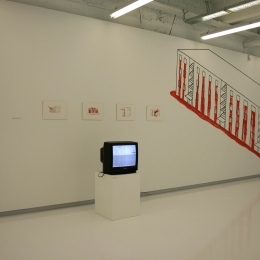art or business
Mark Adam & Marko Mäetamm: Speaking Houses
The exhibition of Estonian artist, Marko Mäetamm, entitled Speaking Houses on view at the kArton Gallery is but a series of gruesome stories told in an ironic tone. The pictures and the related texts speak of the relationship of human beings to their immediate surroundings and dwellings, of the fears hiding in the human subconscious, and of death. Mäetamm selected the façade and courtyards of existing houses in Hungary and painted them in black and white; a flat in Kazinczy street in Budapest, one in Eötvös street, a weekend house in the Balaton countryside, another in Zalaegerszeg, one in Debrecen. Every house has a unique, slightly bizarre story, which is told to us by the building itself: „I am empty at the moment but I can tell you a very sad story about a woman who was recently living inside of „ reads one of the confessions, or “There is a religious sect living in one flat inside of me. A lot of young people, about twenty or thirty years old.”starts another. The stories could actually belong to any house anywhere, still for the artist it was important to choose houses with features that were typical and unique to the given area or country. (Last year the same stories were told with an English and Estonian “architectural approach.”)
Mäetamm's text-based conceptual painting series channels the facts of aggression into the realms of extremes and irony in a grotesque manner, with the open intention of making us laugh at ourselves for our fears relating to death. In the mind of the public, everyday private residences are not linked with scenes of actual aggression. If they are, this usually takes place in secret, behind closed doors. Mäetamm's houses are bleeding! The question here seems not only to be the location of the aggression but also the primary nature of the depicted phenomenon. Marko Mäetamm approaches the possible manifestations of aggression through an impersonal and emotionless narration of the shocking stories. While reading the sincere confessions of the houses it occurs to us to wonder what stories our own houses would tell. In comparison to the earlier works of the artist, which were representative of the neo pop trend, the style of the Speaking Houses shows a change in more than one respect. While in his earlier works, Mäetamm also placed himself in the painting, in these works he becomes "invisible." The storytelling method has been altered as well. Mäetamm's narration technique operates on two levels: on the pseudo-literary level and on the level of the paintings. While in the 90s, the emphasis was placed more on the images themselves, in his latest works this role is assumed by the dark humoured texts. What can be seen in the painting - or, rather, what can be suspected by looking at the painting - is already past tense in comparison to the read story; the image becomes distant from the events in both time and space. The image of the bleeding house is secondary from a dramaturgical standpoint; it serves primarily to support the documentalist (or pseudo-documentalist) attitude.
With his exhibition the artist puts our sense of humour to the test as well, accepting that while some of the viewers will be laughing on their way out, there will probably be others who read the stories of the houses cringing in horror.

